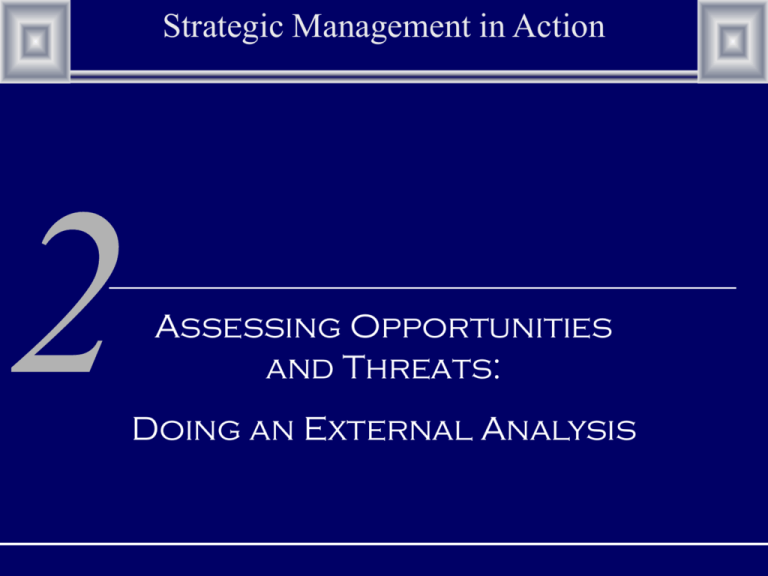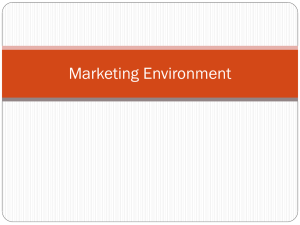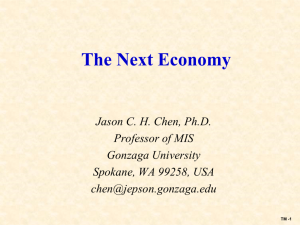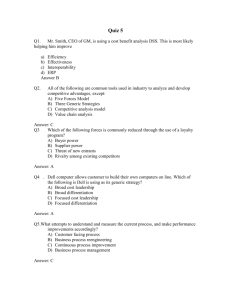SMIA Chap 3 - Assessing Opportunities & Threats: External Analysis
advertisement

Strategic Management in Action Assessing Opportunities and Threats: Doing an External Analysis WHAT IS AN EXTERNAL ANALYSIS? External Analysis Scan and evaluate various external environmental sectors impacting performance • Opportunities Positive external environmental trends that improve the organization’s performance • Threats Negative external environmental trends that hinder the organization's performance Organizations as Open Systems Environment Inputs Processes Outputs Resources: Physical Capital Human Information Organization Functions: Production-Operations Marketing Financial-Accounting Human Resource Mgt. Research and Development Information Systems Managerial Activities: Planning Organization Leading Controlling Goods Services Performance Measures: Financial Productivity Achieve Goal Environment Organization Environment Environment Organization Perspectives on Organizational Environments Environment as Information Perspective • Environmental uncertainty Amount of change and complexity in environment • Environmental stability Amount of change occurring in an organization’s environment Dynamic (rapid) versus Stable (minimal or slow) • Environmental complexity Number of components in environment decision makers must monitor Complex (many) versus Simple (few) Environment as Source of Resources Perspective • Resource scarcity limits resource control Environmental Scanning and External Analysis Environmental Scanning • Know what’s happening in external environment • Recognize and anticipate environmental changes External Analysis • Evaluate various data and trends • Assess impact on the organization Finding Information on the External Environment and Evaluating It • To find information look for • • • • • • • • • Specific data Statistics Analyses Trends Predictions Forecasts Inferences Statements made by experts What's happening or predicted to happen in external sectors • Evaluate whether this information is good or bad Finding Information on the External Environment and Evaluating It • Methods for collecting information • Informal • Customer comments • Reading trade journals and general news media • Talking with suppliers' sales representatives • Formal • External Information System (EIS) • Market and customer surveys Responsibilities for External Analysis at Different Managerial Levels • Lower-level or supervisory managers • Observe and interact • Collect and consolidate • Middle managers • • • • • Coordinate Share with organizational units Gatherer and disseminator Monitor general environmental Make needed strategic changes • Upper management • Evaluate opportunities and threats External Environment Macro Environment Technological Economic Industry Industry Industry Industry Industry Political-Legal Demographic Sociocultural Macro Environment Economic All the macroeconomic data, current statistics, trends, and changes • Interest rates • Monetary exchange rates • Budget deficit-surplus • Trade deficit-surplus • Inflation rates • GNP or GDP • Consumer income, spending, and debt levels • Unemployment levels • Workforce productivity Macro Environment Demographics Current statistical data and trends in population characteristics • Gender • Age • Income levels • Ethnic makeup • Education • Family composition • Geographic location • Birth rates • Employment status Macro Environment Sociocultural • Country's culture • Society's • • • • • • Traditions Values Attitudes Beliefs Tastes Patterns of behavior Macro Environment Political-Legal • Federal, state, and local • Laws • Regulations • Judicial decisions • Political forces General Environment Examples of Significant Legislation Affecting Organizations • • • • • • • • • • • • Occupational Safety and Health Act of 1970 Consumer Product Safety Act of 1972 Equal Employment Opportunity Act of 1972 Worker Adjustment and Retraining Notification Act of 1988 Americans with Disabilities Act of 1990 Civil Rights Act of 1991 Family and Medical Leave Act of 1993 North American Free Trade Agreement of 1993 General Agreement on Tariffs and Trade (GATT) of 1994 U. S. Economic Espionage Act of 1996 Bush Tax Reductions Health Care Reform 2010 Macro Environment Technical Improvements, advancements, and innovations that create opportunities and threats • Communications • Computing • Transportation • Manufacturing • Robotics • Biotechnology • Medicine and medical • Telecommunications • Consumer electronics External Environment Macro Environment Technological Substitute Products Economic Competitive Environment Organization Bargaining Power of Suppliers Bargaining Political-Legal Power of Buyers Sociocultural Current Rivalry Potential Entrants Demographic Competitive Environment Industry Group(s) of organizations producing similar or identical products SIC Codes Competitive variables Compete for customers Secure the necessary resources to convert into products Assess an organization’s specific environment Porter’s five forces model Competitive Environment Potential Entrants Threat of New Entrants Porter’s Five Forces Model Bargaining Power of Suppliers Industry Competitors Suppliers Rivalry Among Existing Firms Threat of Substitute Products or Services Substitutes Bargaining Power of Buyers Buyers Competitive Environment Evaluating the Five Forces Current Rivalry among Existing Firms Threat Numerous competitors Equally balanced competitors Industry sales growth slowing High fixed or inventory storage costs No differentiation or no switching costs Large capacity increments required Diverse competitors High strategic stakes High exit barriers Opportunity –– –– –– –– –– –– –– –– –– Few competitors One or a few strong competitors Industry sales growth strong Low fixed or inventory storage costs Significant differentiation or switching costs Minimal capacity increments required Similar competitors Low strategic stakes Minimal exit barriers Competitive Environment Evaluating the Five Forces Potential Entrants Threat No or low economies of scale No other potential cost disadvantages Weak product differentiation Minimal capital requirements Minimal switching costs Open access to distribution channels No government policy protection Opportunity –– –– –– –– –– –– –– Significant economies of scale Cost disadvantages from other aspects Strong product differentiation Huge capital requirements Significant switching costs Controlled access to distribution channels Government policy protection Competitive Environment Evaluating the Five Forces Bargaining Power of Buyers Threat Buyer purchases large volumes Purchases are significant part Purchases standard or undifferentiated Buyer faces few switching costs Buyer's profits are low Buyer can manufacture products Industry's products aren't important to quality of buyer's products Buyers have full information Opportunity –– –– –– –– –– –– –– Buyer purchases small volumes Purchases aren't significant part of buyer's costs Purchases highly differentiated and unique Buyer faces significant switching costs Buyer's profits are strong Buyer can’t manufacture products Industry's products are important to quality of buyer's products –– Buyers have limited information Competitive Environment Evaluating the Five Forces Bargaining Power of Suppliers Threat Supplying industry has few companies and is more concentrated Supplier's products don’t have substitutes Industry isn’t an important customer Supplier's product is an important input Supplier's products are differentiated Significant switching costs Supplier has ability to do what buying industry does Opportunity –– Supplying industry has many companies and is fragmented –– Supplier's products do have substitutes –– Industry is an important customer –– Supplier's product isn’t an important input –– Supplier's products aren't differentiated –– Minimal switching costs in supplier's products –– Supplier doesn't have ability to do what buying industry does Competitive Environment Evaluating the Five Forces Substitute Products Threat Opportunity – There are few good substitutes There are several not-so-good substitutes –– There are no good substitutes






